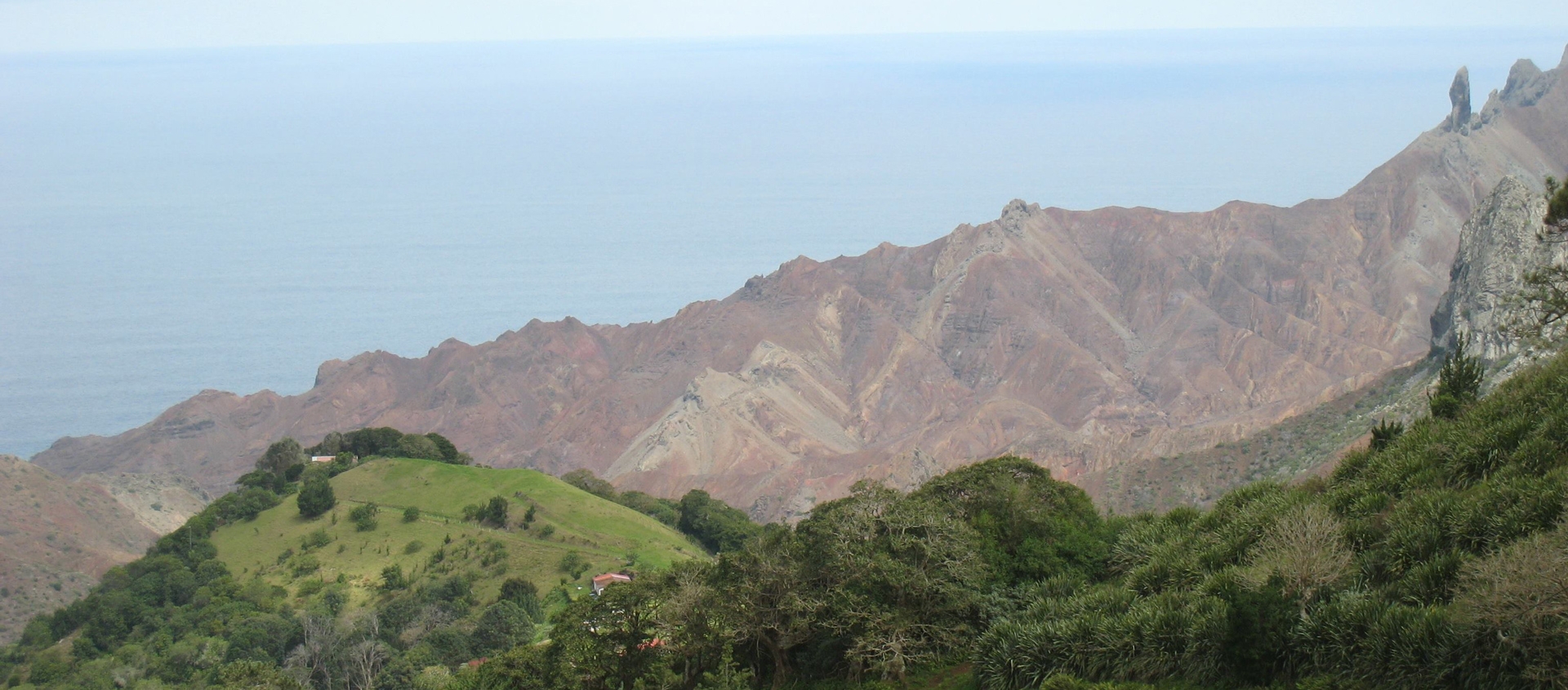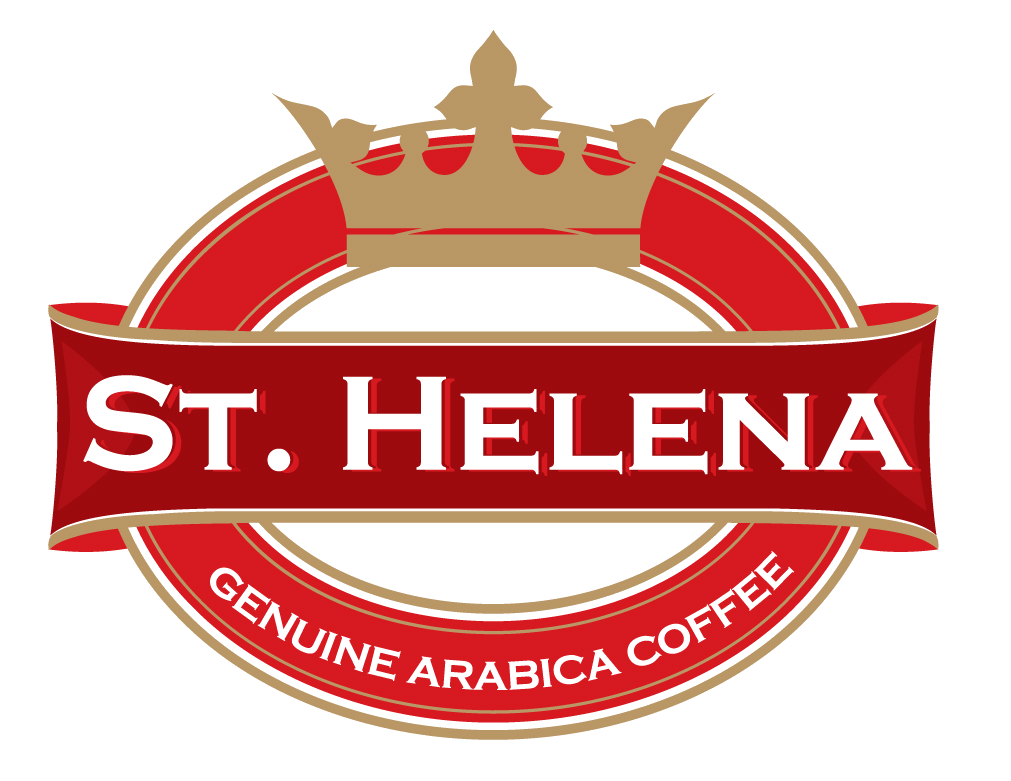
Language / Welcome / Coffee Profile / History / Origins / Napoleon / Coffee of St Helena / Contact Us
The Story of
St Helena Coffee
The Island of St Helena is a small, mountainous, sub tropical island of 122 square kilometres, situated in the South Atlantic Ocean, on latitude 16 degrees south and longitude 5 degrees 45' west. The island was discovered by the Portuguese Admiral Joao da Nova on the 21st May, 1502. He landed where Jamestown stands today and built a chapel there. For over eighty years the Portuguese kept their discovery a secret and used it to replenish their East India fleet.
Origins
St Helena ceased to be Portugal's exclusive preserve in 1588, when Capt. Thomas Cavendish called there during the last stage of his round-the-world voyage in HMS Desire. English and then Dutch ships were soon calling frequently. Following a Dutch attempt to annex the island in 1633, the East India Company decided to fortify it and in 1659 the first permanent settlement was established.
In 1673 St Helena was captured by the Dutch but only four months later was recaptured by the English. The East India Company was granted administration of the island which continued until 1834 when it was brought under the direct control of the British Crown.
The Home of Napoleon
On 16 October 1815, the defeated French emperor, Napoleon Bonaparte arrived at St Helena and began his imposed exile. His home was to be Longwood House, where he was to remain until his death on the 5th May 1821.
Today St Helena is a British Overseas Territory with an English speaking population of approximately five thousand people, mainly of English, African and Chinese descent.
The nearest land is Ascension Island, some 1125 Km north west of St Helena, with the closest mainland port being Cape Town, Republic of South Africa, and some 2720 Km southeast of the island. St Helena Island is one of the most remote places on earth. Access to the island is via the Royal Mail Ship St Helena, operated by Curnow Shipping Ltd. at Falmouth, Cornwall, England.
The Arrival of Coffee
On the 10th February 1733, coffee seeds were brought to the Island of St. Helena, by its then owners The East India Company. The Green Tipped Bourbon Coffee seeds were brought from the coffee port of Mocha in Yemen, on a Company ship the "Houghton" by Captain Philips.
Over the past ten years, St. Helena coffee has become known to coffee connoisseurs world-wide, who have been seduced by its distinctive quality and uniqueness.
St. Helena coffee has a distinctive quality and unique heritage as it is not just a pure Arabica coffee, but a single type of Arabica bean known as Green Tipped Bourbon Arabica.
Green Tipped Bourbon Arabica is a subtle and delicate bean, which requires great care during harvesting, wet processing and roasting, to ensure that all of its wonderful characteristics are preserved for the enjoyment of the true coffee connoisseurs.
Sea View from above Jamestown
Very Remote
With the Island being one of the most remote places on earth, situated in the South Atlantic Ocean, in the path of the South East Trade Winds, St. Helena has one of the purest environments in the world.
Only natural fertilizers are utilized. Livestock manure is not used as it may contain non-organic substances from concentrated animal feed or veterinary treatments.
The coffee is wet processed using pure spring water descending from the Island's peaks, along the Central Ridge.
St. Helena is fortunate in having a rich supply of guano, the dropping of sea birds, which are collected from small out-crops, of rock along the island coasts and used as a natural fertilizer. The guano being extremely rich is allowed to dry and than applied sparingly at the base of the trees during the early stage of the wet Season.
The First Crop
In 2010, St. Helena Trading (UK) Ltd arrived at a joint venture with Solomon & Co. (St. Helena) Plc. to resuscitate the St. Helenian coffee production following the sad demise of the Napoleon Estate and related holdings. The first crop from this cooperation came on stream in March of 2011.
All the former quality and related controls were re-established and surpassed, allowing for the same elegant connoisseur's coffee to return to the exotic coffee market, albeit in small quantities as before. Production is now focussed in the area centered on the historic coffee farm of Bamboo Hedge, collectively known as the Sandy Bay Estates. The land around the adjoining Wranghams Estate is also being cleared for re-newed coffee cultivation and, it is hoped, that this will come on stream in the near future, further assuring a regular and enhanced crop of St.Helenian coffee.
Expanding Horizons
The British and St Helena governments have now completed the construction of an airport, which will completely change St. Helena's accessability with positive implications for both its tourist and agricultural industries.
Language / Welcome / Coffee Profile / History / Origins / Napoleon / Coffee of St Helena / Contact Us
St Helena Coffee Cup Profile
The St Helena coffee is wet processed to the highest possible standard with a wonderful semi-translucent sheen in green bean form.
This delicate bean, once roasted, is well balanced in the cup with good fruity acidity, rich black cherry notes and a pleasing chocolatey aftertaste which lingers on the palate and hints of its Yemeni origins.
Quality Control
St Helena coffee is subjected to the most rigorous quality control. Due to the relatively small quantity of coffee produced, it is possible to give the coffee more attention than a larger coffee industry could expect to do. One of the major challenges for coffee production in St Helena is the deep scarcity of local farm labour.
Coffee Quality Spec
Altitude: 720 meters, but because of its unique geographical position this will be equivalent to more than a 1000 meters of altitude in other coffee producing countries
Total Rain per Year: 3000 mm
Variety: Green Tipped Bourbon
Processing Method: Fully Washed
Mucilage removal: Natural Fermentation
Drying Method: Sun-drying, this process is very slow since it takes approximately 4 months to dry the coffee while it takes just 4-5 days in all other coffee producing countries
Flowering Period: December-April
Harvesting Period: October-February
Language / Welcome / Coffee Profile / History / Origins / Napoleon / Coffee of St Helena / Contact Us
St Helena - History in Brief
Bourbon Coffee Origins
In the coffee trade, the name 'Bourbon' has come to be associated with a variety of coffee plant originating in Yemen which spread into South America via the French Caribbean. Louis XV already had some coffee plants flourishing in his greenhouse at Versailles. He was particularly passionate about brewing the coffee, tending to them personally, and harvesting, processing, roasting, and brewing them himself. He had Madame du Barry portrayed as a Sultana, coffee cup in hand.
Napoleons Arrival
Napoleon arrived on St Helena on 16 October 1815 after the defeat that summer by the British and Prussians at Waterloo. The likelihood of his escaping was as remote as the island itself. The fortifications were truly formidable: gun emplacements bristled from every strategic point overlooking the ocean, and the lessons of the Dutch invasion had been learnt, so that inland passes were covered from the heights.
A Measure of Celebrity
As a result of the Napoleonic connection, the island had achieved a measure of celebrity and its cottage coffee industry enjoyed a brief renaissance. The owner of the estate at Bamboo Hedge, G. W. Alexander, sent a sample to a coffee broker in London, William Burnie & Co., who pronounced it 'of a very superior quality and flavour' and suggested that it might fetch as much as £7 per hundredweight.
The Wrangham Coffee Plantation, St Helena
The Solomon & Company (St Helena) Plc Wranghams Coffee Plantation lies on the scenic strata of the Sandy Bay Ridge.
The Plantation covers 4.3 acres of land, hosting approximately 2500 productive Coffee Trees, surrounded by layers of forest trees which serve as windbreaks and help with moisture retention.
The Plantation was developed by the Company in 2011 as part of the expansion plans to fulfil and sustain a growing international demand for St Helena Coffee. The Plantation was developed from naturally regenerated saplings from parent stock, originally introduced to the Island as seeds brought aboard an East India Company Ship, the ‘Houghton’ from the coffee port of Mocha in Yemen in the 18th Century.
Little history is associated with the actual Coffee Plantation however it sits adjacent to its namesake ‘Wranghams House’. Wranghams House is one of the Island traditional country houses. The construction is not mentioned in any records however an entry was found, which read: “19th February 1745: Four acres in Sandy Bay leased to one Francis Wrangham”. It is presumed therefore that the house would have been built shortly after.
In 1817 the house is listed as being owned by Major W Seale. Intriguingly, on Read’s 1817 Map (above) you will find the property named The Castle of Otranto. Read’s Map is not particularly accurate by modern standards. The island is misshapen and the internal distances are not correct, so judging exactly where The Castle of Otranto is located can only be an estimate but it is generally agreed that the appellation refers to the building we know as Wranghams House. The fact that it is marked as owned by one ‘Major W Seale’ helps as he is listed as owning Wranghams at that time.
The House remained in private hands until 1972 when it was sold to the Government of St Helena, who restored it. It was used until the early 2000’s as accommodation for visiting government officials. The House was always damp and in later years many felt it to be below an acceptable standard. After standing derelict for many years, the House was advertised for sale in December 2013 and finally a sale followed at the latter part of 2014. Renovation works were completed by new owners Neil and Deborah Fantom in December 2016 and Wranghams House is now, once again, one of the Island’s fine country houses.
Language / Welcome / Coffee Profile / History / Origins / Napoleon / Coffee of St Helena / Contact Us
Our Office
St Helena Trading (UK) Limited
Lower Ground Floor,
164 Old Brompton Rd,
Kensington,
London, SW5 0BA
United Kingdom.
Contact Us
St Helena Trading (UK) Limited is a British trading company responsible for the importing, distribution and marketing of St Helena coffee internationally.


